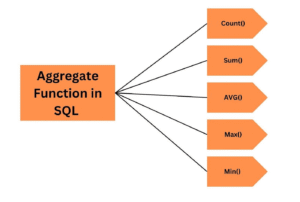Aggregation Functions in SQL
What are Aggregation Functions?
Aggregation functions in SQL are built-in functions that perform a calculation on a set of values and return a single value. These are commonly used with GROUP BY to summarize large datasets, such as totals, averages, maximum values, etc.
Common Aggregate Functions:
1. COUNT()
Purpose: Counts the number of rows.
Syntax:
Example: Count how many students are in the table.
2. SUM()
Purpose: Adds up all values in a numeric column.
Syntax:
Example: Total marks of all students.
3. AVG()
Purpose: Calculates the average of a numeric column.
Syntax:
Example: Find the average marks in a subject.
4. MIN()
Purpose: Finds the minimum (smallest) value in a column.
Syntax:
Example: Youngest student’s age.
5. MAX()
Purpose: Finds the maximum (largest) value in a column.
Syntax:
Example: Highest salary among teachers.
Using Aggregate Functions with GROUP BY
You can combine aggregate functions with the GROUP BY clause to compute summaries per group (like per department, class, etc.).
Example:
This will show the average salary in each department.
